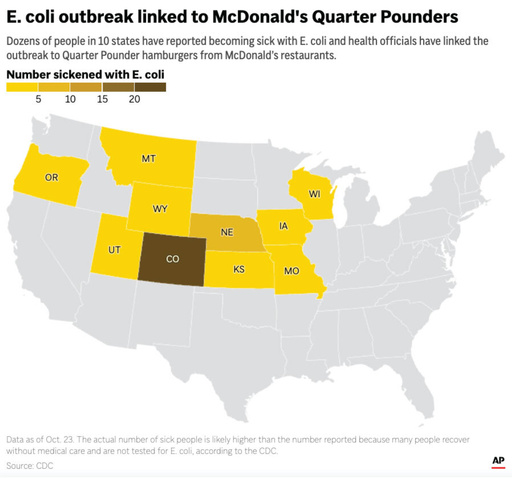
Outbreaks of foodborne illnesses, while uncommon in well-established restaurant chains, can still occur. Recently, McDonald’s has been linked to an E. coli outbreak associated with their Quarter Pounder hamburgers, affecting at least 49 individuals across 10 states, resulting in one fatality and 10 hospitalizations. In response, McDonald’s has ceased the distribution of slivered onions and temporarily withdrawn the Quarter Pounder from menus in various states.
This article highlights a history of recent foodborne illness incidents that have not only impacted consumers but also prompted businesses to adapt and influenced food safety regulations in the United States.
**Wendy’s**
In August 2022, Wendy’s took action by withdrawing lettuce from its sandwiches within restaurants in Michigan, Ohio, and Pennsylvania after patrons reported illnesses. The Centers for Disease Control and Prevention (CDC) investigated whether romaine lettuce was the cause of an E. coli outbreak that affected at least 37 people and whether the romaine used by Wendy’s had also been available at other venues. Additionally, one case was recorded in Indiana, as noted by the CDC.
**Chipotle**
Chipotle experienced a significant E. coli outbreak in 2015, which resulted in over 50 illnesses, prompting the temporary closure of several locations on the West Coast. Shortly after, about 30 students from Boston College, including some members of the men’s basketball team, reported gastrointestinal issues after dining at a Chipotle restaurant. Although federal officials declared the outbreak resolved by February 2016, the chain made the decision to close all its restaurants to provide employee retraining and assessment of safety practices. Unfortunately, by the end of 2016, Chipotle Co-CEO Montgomery Moran stepped down as the company experienced a drop in sales. In 2020, Chipotle agreed to pay a record penalty of $25 million to settle criminal charges stemming from incidents between 2015 and 2018, which involved over 1,100 sick customers in the U.S. The company acknowledged that improper safety protocols contributed to these illnesses in locations such as Los Angeles, Boston, and Ohio. Despite this tumultuous history, Chipotle has emerged as a leading chain restaurant, generating nearly $10 billion in sales last year.
**Taco Bell**
A food safety issue arose for Taco Bell in December 2006 when the company retracted green onions from its 5,800 nationwide locations after investigators found a serious strain of E. coli. This outbreak resulted in at least 71 illnesses across New Jersey, New York, Pennsylvania, and Delaware, leading to multiple hospitalizations. Some individuals even developed hemolytic-uremic syndrome, a severe kidney condition. Investigations later indicated that contaminated lettuce was likely to blame, affecting various menu items. In the wake of this crisis, Taco Bell launched an extensive advertising campaign and engaged their president in media appearances to reassure customers about the safety of their food. The brand made a full recovery and reported a 6% sales increase last year, alongside the opening of over 200 new outlets.
**Jack in the Box**
The period between 1992 and 1993 witnessed a severe outbreak associated with Jack in the Box hamburgers, leading to four deaths and over 700 illnesses reported across states such as Washington, Idaho, California, and Nevada due to E. coli contamination from undercooked beef. This tragedy prompted a re-evaluation of food safety protocols in the U.S. Experts revealed that the CDC pinpointed five slaughter plants in the U.S. and one in Canada as the likely origin of the contaminated meat. Following these investigations, the U.S. Department of Agriculture implemented the Hazard Analysis and Critical Control Point system, which was designed to enhance identification and management of hazards within food production. As a result of the outbreak, Jack in the Box faced significant financial losses, exceeding $44 million in 1993, and struggled to report profits for three years afterward. Nevertheless, the company has successfully recovered and recently announced sales of $1.7 billion, marking its third consecutive year of double-digit sales growth.
